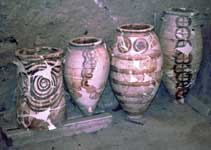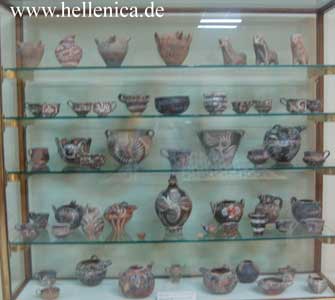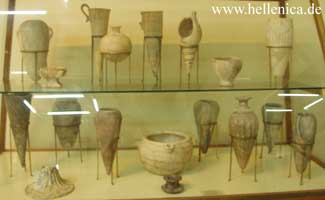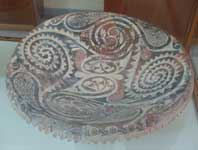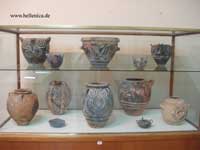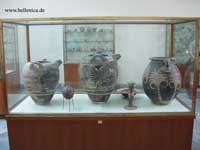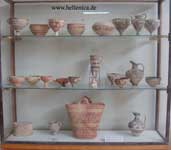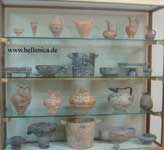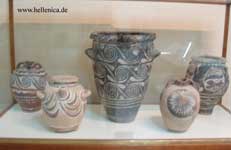- University of Oklahoma: Gallery of outstanding Minoan pottery vases, pouring vessels and rhyta.
- Doumas Kristos' description of local pottery and Cretan imports from the excavations at Akrothiri (Santorini) (in English)
- GiselaWalberg finds little influence between Minoan vase-paintings and glyptic motifs (in English)
- Material and Techniques of the Minoan Ceramics of Thera and Crete, Thera Foundation
- A LM IA Ceramic Kiln in South-Central Crete, Joseph W. Shaw et al., Hesperia Supplement 30, 2001.
- Victor Bryant, Web Tutorial for Potters, under Crete & Mycenae
|
|
Minoan pottery is more than a useful tool for dating the mute ). The mottling was produced by uneven firing of the slip-covered pot, with the hottest areas turning dark. Considering that the mottling was controled into a pattern, touching with hot coals was probably used to produce it. The effect was paralleled in cups made of mottled stone. EM III Pottery Of the period Hutchinson says:[4] "... the most remarkable feature is the expansion of central Cretan sites ... at the expense of east Cretan sites ..." In the latest brief transition (EM III), wares in eastern Crete begin to be covered in dark slip with light slip-painted decor of lines and spirals; the first checkered motifs appear; the first petallike loops and leafy bands appear, at Gournia (Walberg 1986). Rosettes appear and spiral links sometimes joined into bands. These motifs are similar to those found on seals. In north central Crete, where Knossos was to emerge, there is little similarity: dark on light linear banding prevails; footed goblets make their appearance (Example). Middle Minoan Of the palace at Knossos and smaller ones like it at Phaestos, Mallia and elsewhere, Willetts says[5]: "These large palaces were central features of sizable cities... Apparently they were also administrative and religious centres of self-supporting regions of the island." The rise of the palace culture, of the "old palaces" of Knossos and Phaistos and their new type of urbanized, centralized society with redistribution centers required more storage vessels and ones more specifically suited to a range of functions. In palace workshops, standardization suggests more supervised operations and the rise of elite wares, emphasizing refinements and novelty, so that palace and provincial pottery become differentiated. The forms of the best wares were designed for table and service. In the palace workshops, the introduction from the Levant of the potter's wheel in MMIB enabled perfectly symmetrical bodies to be thrown from swiftly-revolving clay.[6] The well-controlled iron-red slip that was added to the color repertory during MMI could be achieved only in insulated closed kilns that were free of oxygen or smoke. Pithoi
Jar from Knossos Any population center requires facilities in support of human needs and that is true of the palaces as well. Knosses had an extensive sanitation and water supply system, which is evidence that it was not a ceremonial labyrinth or large tomb. Liquid and granular necessities were stored in Pithoi located in magazines, or storage rooms, and elsewhere. Pithoi make their earliest appearance just before MMI begins and continue into Late Minoan, becoming very rare by LMIII. (Examples 1, , ) Some of the rhyta are ornate libation vessels, such as the noted "Bull's-head Rhyton" found at Knossos. The Bull's Head Rhyton, however, was a specific type of which many instances have been found. The bull's head is found in ceramic as well. Other noted stone vases of LM IA and II are the "Harvester Vase" ( , (Early Cypriote) |
|||||||||||||||||
| WATER JAR? | u-do-ro | *hudroi (pl) | hydros (sing), a water-snake | "water (jars)" | , Examples 2, Examples 3). This style started in LM II and went on into LM III. The palace style was pretty much confined to Knossos. In the late manifestation of the palace style, fluent and spontaneous earlier motifs stiffened and became more geometrical and abstracted. Egyptian motifs such as papyrus and lotus are prominent. Plain and Close Styles The Plain Style and Close Style developed in LM IIIA, B from the Palace Style. In the Close Style the Marine and Floral Styles themes continue, but the artist manifests the horror vacui or "dread of emptiness". The whole field of decoration is filled densely. (Examples 1, Examples 2). The Stirrup Jar is especially frequent. The Middle East Style IIIC Subminoan Finally, in the Subminoan period, the geometric designs of the Dorians become more apparent. (Example) Notes
References
External links Further reading
Retrieved from "http://en.wikipedia.org"
 |
|
||||||||||||

